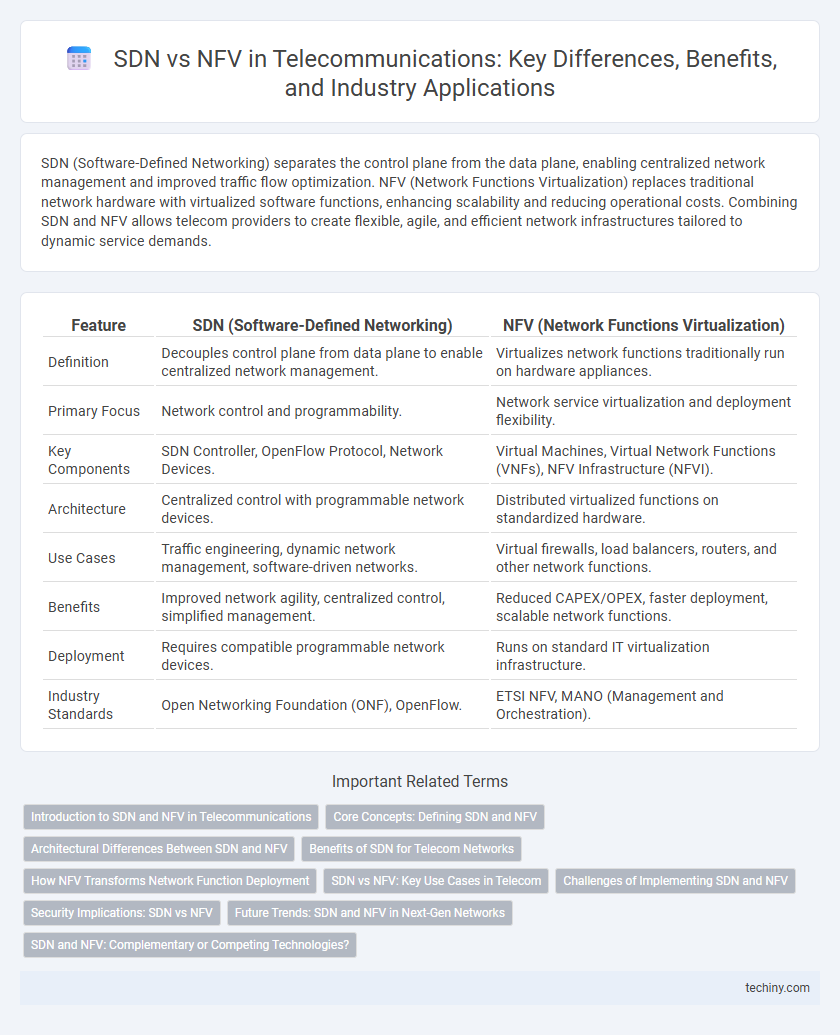SDN (Software-Defined Networking) separates the control plane from the data plane, enabling centralized network management and improved traffic flow optimization. NFV (Network Functions Virtualization) replaces traditional network hardware with virtualized software functions, enhancing scalability and reducing operational costs. Combining SDN and NFV allows telecom providers to create flexible, agile, and efficient network infrastructures tailored to dynamic service demands.
Table of Comparison
| Feature | SDN (Software-Defined Networking) | NFV (Network Functions Virtualization) |
|---|---|---|
| Definition | Decouples control plane from data plane to enable centralized network management. | Virtualizes network functions traditionally run on hardware appliances. |
| Primary Focus | Network control and programmability. | Network service virtualization and deployment flexibility. |
| Key Components | SDN Controller, OpenFlow Protocol, Network Devices. | Virtual Machines, Virtual Network Functions (VNFs), NFV Infrastructure (NFVI). |
| Architecture | Centralized control with programmable network devices. | Distributed virtualized functions on standardized hardware. |
| Use Cases | Traffic engineering, dynamic network management, software-driven networks. | Virtual firewalls, load balancers, routers, and other network functions. |
| Benefits | Improved network agility, centralized control, simplified management. | Reduced CAPEX/OPEX, faster deployment, scalable network functions. |
| Deployment | Requires compatible programmable network devices. | Runs on standard IT virtualization infrastructure. |
| Industry Standards | Open Networking Foundation (ONF), OpenFlow. | ETSI NFV, MANO (Management and Orchestration). |
Introduction to SDN and NFV in Telecommunications
Software-Defined Networking (SDN) centralizes network control by decoupling the control plane from the data plane, enabling programmable and dynamic network management. Network Functions Virtualization (NFV) abstracts network services from dedicated hardware to virtual machines, promoting flexibility and cost efficiency in telecommunications infrastructure. Together, SDN and NFV transform traditional telecom networks by enhancing scalability, agility, and operational automation.
Core Concepts: Defining SDN and NFV
Software-Defined Networking (SDN) separates the network control plane from the data plane, allowing centralized network management and dynamic configuration through programmable interfaces. Network Functions Virtualization (NFV) virtualizes traditional network functions, such as firewalls and load balancers, running them as software on standard servers instead of dedicated hardware. Together, SDN and NFV enable flexible, scalable, and cost-efficient telecommunications infrastructure by decoupling hardware and software components.
Architectural Differences Between SDN and NFV
Software-Defined Networking (SDN) separates the control plane from the data plane, enabling centralized network management through a programmable controller, while Network Functions Virtualization (NFV) virtualizes network services on commodity hardware using software-based virtual machines or containers. SDN architecture relies on a logically centralized controller that dynamically configures network devices, whereas NFV architecture focuses on decoupling network functions from dedicated appliances and running them as virtualized instances across distributed infrastructure. The modular, controller-centric design of SDN contrasts with NFV's emphasis on service chain orchestration and resource abstraction within virtualized environments.
Benefits of SDN for Telecom Networks
Software-Defined Networking (SDN) enhances telecom networks by providing centralized control and programmability, enabling faster service deployment and improved network flexibility. SDN's ability to dynamically manage traffic flows reduces operational costs and optimizes bandwidth utilization. This architecture supports seamless scalability and rapid adaptation to changing network demands, crucial for 5G and beyond.
How NFV Transforms Network Function Deployment
NFV revolutionizes network function deployment by virtualizing hardware-dependent functions into software-based services running on standard servers, significantly reducing reliance on proprietary hardware. This virtualization enables rapid provisioning, dynamic scaling, and automated management of network functions, leading to improved agility and cost efficiency. Operators can deploy, update, and optimize services in real time, enhancing overall network flexibility compared to traditional SDN implementations.
SDN vs NFV: Key Use Cases in Telecom
SDN (Software-Defined Networking) enhances telecom networks by centralizing control, enabling dynamic traffic management and improving network agility for services like virtual private networks and mobile data optimization. NFV (Network Functions Virtualization) focuses on decoupling hardware from network functions, facilitating flexible deployment of virtualized network services such as firewalls, load balancers, and EPC (Evolved Packet Core) elements. Telecom operators leverage SDN for real-time network programmability, while NFV supports rapid scaling and cost-efficient service provisioning, crucial for 5G and IoT infrastructure.
Challenges of Implementing SDN and NFV
Implementing SDN and NFV in telecommunications faces challenges such as integration complexity with existing legacy infrastructure and interoperability issues between multi-vendor environments. Security concerns arise from the centralized control plane in SDN and the dynamic nature of NFV's virtualized functions, increasing vulnerability to cyberattacks. Scalability and performance optimization are critical, requiring advanced management and orchestration tools to ensure reliable network service delivery.
Security Implications: SDN vs NFV
SDN enhances network security through centralized control, enabling dynamic threat detection and rapid mitigation by isolating compromised segments. NFV introduces security challenges by relying on virtualized environments that may increase attack surfaces, requiring robust hypervisor and orchestration platform protections. Combining SDN's programmable framework with NFV's flexible service deployment necessitates integrated security policies to address vulnerabilities unique to each technology.
Future Trends: SDN and NFV in Next-Gen Networks
Future trends in telecommunications emphasize the integration of Software-Defined Networking (SDN) and Network Functions Virtualization (NFV) to deliver agile, scalable, and cost-efficient next-generation networks. SDN enhances centralized control and programmability, while NFV virtualizes network services for rapid deployment and flexibility, enabling 5G, edge computing, and IoT applications. Emerging advancements in AI-driven automation and cloud-native architectures further accelerate the convergence of SDN and NFV, transforming network management and optimization.
SDN and NFV: Complementary or Competing Technologies?
SDN (Software-Defined Networking) and NFV (Network Functions Virtualization) serve distinct yet complementary roles in modern telecommunications by enabling agile network management and flexible service deployment. SDN centralizes network control through programmable interfaces to optimize traffic flow, while NFV virtualizes network functions traditionally tied to hardware, allowing dynamic scaling and cost reduction. Together, these technologies enhance operational efficiency and innovation, transforming network architecture rather than competing for dominance.
SDN vs NFV Infographic

 techiny.com
techiny.com